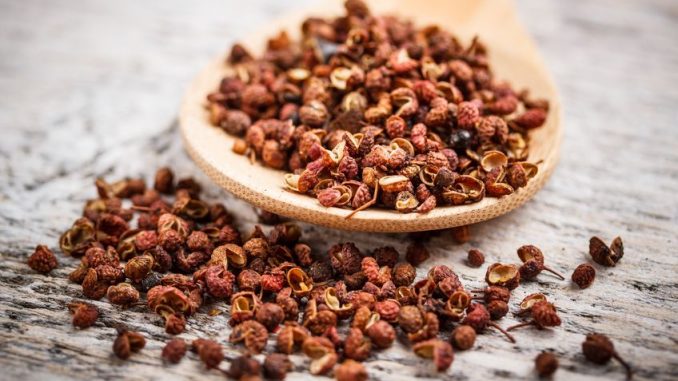
Szechuan pepper (or Sichuan pepper) might not be as familiar to the typical customer wondering the aisles looking for hot spices but it certainly ought to be better known. For a start it has a mouth tingling effect which is almost indescribable were it not for the number of writers who spend ages trying to characterise it.
The spice is widely used throughout Asia from Nepal and India to China and Taiwan, as a spice simply for its very pleasant pungent and tingling sensation. You might know it as Chinese Coriander or the pepper from the Prickly Ash Tree. It is highly characteristic of particular cuisine especially from the region of Sichuan in China. It is not however sansho pepper which is obtained from a similar species and has slightly different effects. There is quite a bit of confusion over the naming and undoubtedly the sourcing of these peppers.
Szechuan pepper is usually available in the form of red-brown berries, rather like peppercorns and is obtained from a number of species of the Zanthoxylum genus. There are however, two main contributors, Z. simulans and Z. bungeanum. The genus belongs to the citrus or rue family even though it is called a pepper but from a botanical point of view has no relationship with either chilli or black pepper or white pepper. The spice is also similar to that of Timur which is a related Zanthoxylum species (Z. armatum). Most Sichuan pepper is sourced from a variety of plants so it is difficult to establish a source which is probably prone to adulteration.
The husk or hull (pericarp) around the seeds may be used whole, especially in Sichuan cuisine, and the finely ground powder is one of the main ingredients for five-spice powder. It is also used in traditional Chinese medicine for treating toothache. The pericarp is most often used, but the leaves of various species are used in some regions of China. Used alone or in combination with pungent spices, this extract provides many options for delivery of unique sensations in various food applications, such as snacks, soups, sauces, salsas, dressings, prepared meals, beans, marinades, meat and poultry products, and chocolate and other confections.
What Causes The Peppery Sensations In Szechuan Pepper?
Apparently, it adds spiciness to food without contributing the heat normally associated with pepper. The sensations on the tongue are produced by natural alkylamides called sanshools. The main alkylamide, α-hydroxysanshool, is sourced from the pericarp of the fruit. These particular alkylamides stimulate various sensory neurons innervating the mouth by targeting two chemosensitive members of the transient receptor potential (TRP) channels, TRPV1 and TRPA1 (Bautista et al., 2008; Menozzi-Smarrito et al., 2009). In fact this has been an exciting find for neuroscientists trying to understand the tingling sensations behind such conditions as ‘pins and needles’. The sanshools are compounds associated with this sensation and are targeted by pharmaceutical firms as analgesics and anti-inflammatories..
Some individuals may be more sensitive to the numbing sensation or may experience allergic reactions. As with any plant or herbal product, it is advisable to use this pepper under appropriate guidance, and if you have any specific health concerns or conditions, it’s always recommended to consult with a healthcare professional.
References
Bautista, D. M., Sigal, Y. M., Milstein, A. D., Garrison, J. L., Zorn, J. A., Tsuruda, P. R., … & Julius, D. (2008). Pungent agents from Szechuan peppers excite sensory neurons by inhibiting two-pore potassium channels. Nature neuroscience, 11(7), pp. 772-779. doi:10.1038/nn.2143
Menozzi-Smarrito, C., Riera, C. E., Munari, C., Le Coutre, J., & Robert, F. (2009). Synthesis and evaluation of new alkylamides derived from α-hydroxysanshool, the pungent molecule in Szechuan pepper. Journal of Agricultural and Food Chemistry, 57(5), pp. 1982-1989 (Article).


Leave a Reply